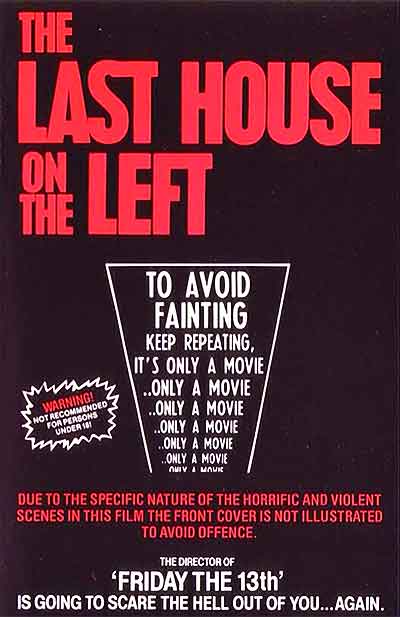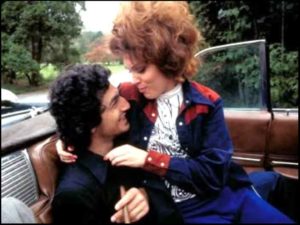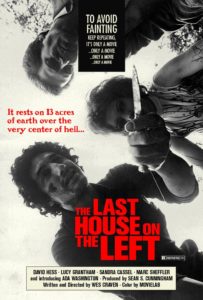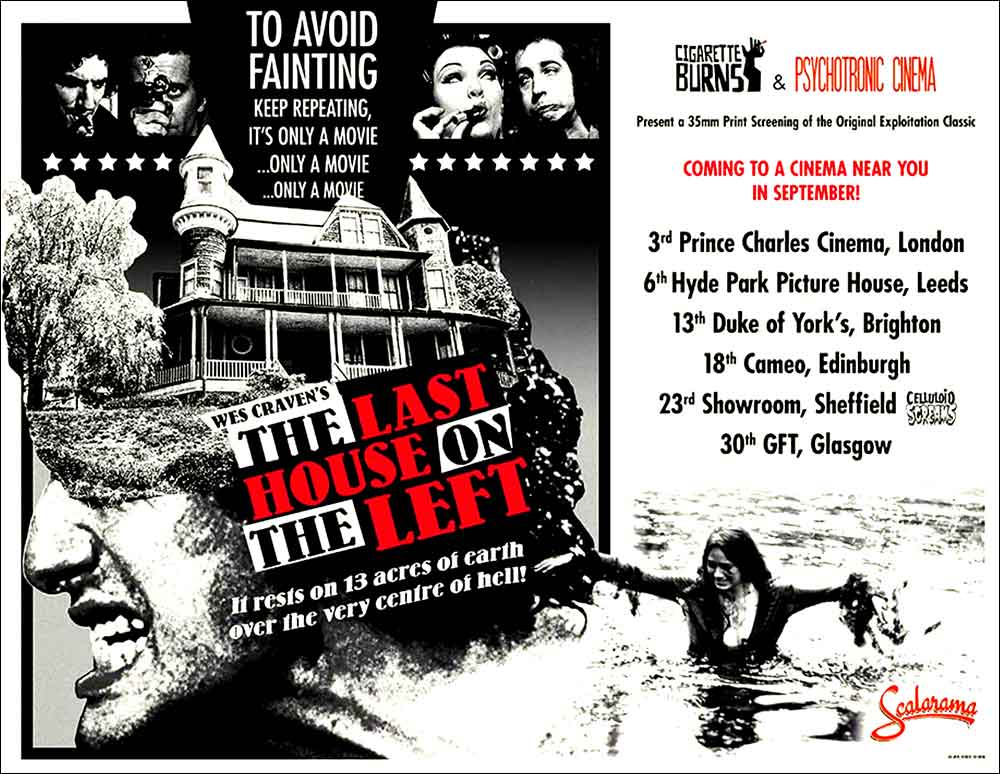 The original LAST HOUSE ON THE LEFT: there exist better known films in the splatter movie pantheon, and certainly better made ones, but you’ll have a difficult time finding a meaner, nastier film—a film, I might add, whose continuing influence on modern horror/exploitation cinema is undeniable.
The original LAST HOUSE ON THE LEFT: there exist better known films in the splatter movie pantheon, and certainly better made ones, but you’ll have a difficult time finding a meaner, nastier film—a film, I might add, whose continuing influence on modern horror/exploitation cinema is undeniable.
Back in 1972 there was nothing else quite like THE LAST HOUSE ON THE LEFT. It marked the debut of writer/director Wes Craven, supported by producer Sean S. Cunningham (who went on to direct the original FRIDAY THE 13th). In those days before THE EXORCIST, THE TEXAS CHAINSAW MASSACRE or CANNIBAL HOLOCAUST, Craven and Cunningham set out to create the most extreme film they possibly could. The inspiration was Ingmar Bergman’s 1960 classic THE VIRGIN SPRING, which was considered quite shocking for its time. Craven and Cunningham’s unaccredited remake, initially titled NIGHT OF VENGEANCE and then KRUG AND COMPANY, far outdid Bergman’s film—and virtually every other—in shock and awe.
It was a no-budget affair retitled LAST HOUSE ON THE LEFT by financier/distributor Hallmark Releasing, and released to great success with the legendary tagline “TO AVOID FAINTING KEEP REPEATING, IT’S ONLY A MOVIE…ONLY A MOVIE…ONLY A MOVE…” (The full story of LAST HOUSE’S making and reception is told in David A. Szulkin’s 1997 book WES CRAVEN’S LAST HOUSE ON THE LEFT: THE MAKING OF A CULT CLASSIC, which I recommend.)
There exist several outright rip-offs of LAST HOUSE, from 1974’s NIGHT TRAIN MURDERS to 2005’s CHAOS, as well as countless more pictures inspired by it to varying degrees, including THRILLER: A CRUEL PICTURE, THE CANDY SNATCHERS, I SPIT ON YOUR GRAVE and Craven’s own THE HILLS HAVE EYES. There was also the inevitable remake, which appeared in 2009, and which I strongly doubt will ever displace the original.
Teenage Mari and her friend Phyllis are en route to a concert one night. They enter a shady part of town hoping to score some pot, and end up in the clutches of Krug, an escaped psychopath, and his gang. The retinue includes the amoral Sadie, the equally conscienceless Weasel, and Krug’s mentally impaired son Junior, who Krug has hooked on heroin to keep him under control. These human monsters take Mari and Phyllis into the woods, where they sexually humiliate the girls before brutally raping and killing them both.
After the slaughter is over the killers seek refuge in the first house they come to: that of John and Estelle Collingwood, Mari’s parents! That night Estelle overhears Krug and co. talking about murdering the girls, leading to an orgy of vengeance.
John booby traps the house while Estelle leads Weasel outside…and, during an impromptu blowjob, bites his dick off. John decapitates Krug with a chainsaw, but not until after the latter has convinced Junior to shoot himself in the head. Sadie is dealt with by Estelle, who slashes her throat and leaves her to expire in the backyard swimming pool. Thus the bad guys have been done away with, but the Collingwoods are left blood-spattered and irrevocably debased by the violence they’ve committed.
Wes Craven freely admits he didn’t know what he was doing when he made THE LAST HOUSE ON THE LEFT (he was apparently “stoned most of the time anyway”), which explains the crudity and amateurishness of the project. The early scenes are borderline unwatchable with their clumsy staging and wooden performances, but once Mari and Phyllis are taken into the woods by Krug and co. the picture ignites. The lack of polish enhances the horror of these scenes, which have a rawness few other films can hope to match. The presence of David Hess as Krug is a big plus: Hess makes for a terrifyingly convincing psycho in a role that became so iconic the actor has spent much of the remainder of his career repeating it (in films like THE HOUSE AT THE EDGE OF THE PARK, HITCH-HIKE and Craven’s SWAMP THING).

The final showdown between Krug’s gang and Mari’s parents presents Wes Craven’s favorite theme of normal folks pushed to psychotic extremes (showcased in later Craven opuses like THE HILLS HAVE EYES and THE PEOPLE UNDER THE STAIRS) in its purest, most undiluted form. The intercutting between the Krug-Dr. John chainsaw duel and the outdoor fight to the death between Sadie and Estelle conveys a bone-rattling intensity that belies Craven’s amateur status.
The key to the film, perhaps, lies in two short scenes. The first occurs during the torture of Mari and Phyllis when their tormenters suddenly appear overcome by remorse at the crime they’re committing, and the second at the very end, when Mari’s parents, after avenging their daughter’s murder, strike a shamed pose. In both instances the perpetrators of the violence, justified or not, have been unalterably sullied by their actions–as by extension has the viewer. Ugly, grotesque and vicious this film may be, but it’s also profoundly affecting. You may not like it, but I guarantee THE LAST HOUSE ON THE LEFT will leave a lasting impression.
Vital Statistics
THE LAST HOUSE ON THE LEFT (a.k.a. NIGHT OF VENGEANCE, KRUG AND COMPANY, SEX CRIME OF THE CENTURY)
Hallmark Releasing Corp.
Director: Wes Craven
Producer: Sean S. Cunningham
Screenplay: Wes Craven
Cinematography: Victor Hurwitz
Editing: Wes Craven
Cast: Sandra Cassell, Lucy Grantham, David A. Hess, Fred Lincoln, Jeramie Rain, Marc Sheffler, Gaylord St. James, Cynthia Carr, Ada Washington, Marshall Anker, Martin Kove


